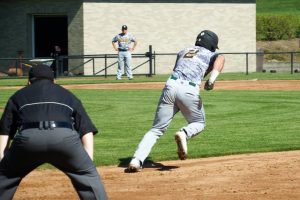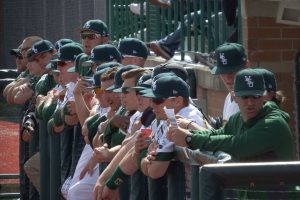The Base Stealing Decline in College Baseball
Matt Talarico, StealBases.com
(Don’t have time to read the article right now? Check out the original audio response to the article above!)
I recently was forwarded an article from NCAA.com about the decline in stolen bases in college baseball. Daniel Wilco’s article can be found here. Give it a quick read if you have a second. I loved the article and think the author is accurate in his assessment but I disagree with the view we take as coaches with base stealing.
There is no debate on the numbers Wilco presented in the article. We will play teams who, without a doubt, attempt very few stolen bases. The general consensus is the steady decline of stolen bases over the last few decades is due to pro baseball going away from “taking the risk.” I tend to agree with him because baseball is a copycat sport. You can see college baseball copy pro baseball quite a bit. For example, look at the various new funky pitching windups, quick pitches, and hesitations all over college baseball this season.
When you look at a pro player’s stats through the season, they show stealing at a 75% percent success rate is the minimum to warrant the risk. While I want to be clear that I am not an advocate for high risk base stealers, I also want to respectively disagree with these stats. Well, maybe I just want to change the perspective a bit.
First, I do think stolen bases in pro baseball are a great weapon and should be developed more. I think the investment has to be organization wide and I don’t know if teams see the value to commit past just looking at some pitcher tendencies, allowing their fastest guys to steal just 20 bags in 162 games. An investment in base stealing could pay dividends if done the right way.
Second, for some of us at the college level or high school level it is a bit of a mistake to make our style completely based on what the Yankees and Red Sox do. Meaning, we have years where we know our offense could be a bit low after graduation or the draft (check WSU 2017 stats). On a year like that, our chances of driving a guy in from first base were low. To score we had to get guys to second or third base as often as possible, trying to avoid the sacrifice bunt if possible. This year’s team is different and next year’s will be too. This doesn’t mean in 2017 we wanted to steal at less than a 75% rate but it was a year where we had to push it by working really hard in the off season.
The comparison to college and pro stats could be another article completely. For now I would like to stick with college baseball (although I’m sure a lot of this would apply to pro baseball as well).

There is a weight on stolen bases depending on the situation and the time of the year. A stolen base up 4 runs in the 8th is very different than a stolen base with one out in a tie game in the 9th. A stolen base in the conference tournament is much more valuable than a midweek game two weeks into the year.
I feel the real problem with base stealing is that coaches do not look at it from a development standpoint. Base stealing can be taught and it can be taught to all players on your team. Not everyone will play the Rickey Henderson role, but that doesn’t mean they can’t have a role in creating pressure and becoming a threat in certain situations.
If you compare the development process of a base stealer to a hitter’s process it is typically very different. Coaches understand hitters are each very unique and require different paths to success, a base stealer doesn’t get the same patience.
Let’s break hitters down into 3 categories (I realize there are exceptions):
- Hitters who are natural and can come in and immediately contribute as a freshman.
- Hitters who need to sit a year or two and develop. This player hits every day and receives instruction both in private and in a group setting. When his spot is someday open he will come in and be able to contribute. This player may be redshirted but also may get at bats for “experience” so he is ready when he is an everyday player.
- Hitters who need to play but are not ready to hit. This player is forced to learn on the fly because the team has a need for him defensively. He hits low in the lineup and you hope to get some contribution while he learns to swim in the deep end of the pool. The coach will work with him through the entire year to try to get him serviceable by the end.
Conclusions made for hitting development:
Offensive numbers have increased through the years because teams have hired educated coaches, who now have better resources (the internet) and are putting in more intentional one-on-one, evidence-based work.
*This process applies to strength training, pitching, and defense. This includes catching development. Go to twitter right now and look up the quality of catching information out there for free (or click this link). There are also developments in how people hold runners in college by managing looks at second or demanding the pitcher’s delivery to be a 1.2 to the plate.

Lets compare this to a typical base stealer’s process:
- A runner who can naturally steal. This player is usually very fast and attempts to steal whenever the coach gives him the sign. If he is safe in his first few attempts the coach might even give him the “green light” or the freedom to run without a sign.
- A runner who needs to develop. The coach doesn’t typically work with him. While he could have developed into a great base stealer he is stuck only running in “safe counts.” He typically will never get the “green light” so he will never receive the lessons from failing. If he does fail then it goes undiscussed or looked at as a bad coaching decision. This “failure” feeling will lead to hesitation for both the coach and the player in the future.
- A runner who is slow or starts out the season with some rough luck. These players will never have a role in the 2, 3, 4 years they are in college. They will be station-to-station for the most part.
*For all 3 the majority of their base stealing work will be with the strength coach and will be focused on running form. This will neglect ideas of getting better jumps, understanding momentum, picking up tendencies, learning to return, etc. Even though they get faster they won’t have a skill set that makes them confident they are not high risk.
Conclusions made for base stealing development (I understand this is a generalization):
Base stealing numbers have decreased due to the effort in development at nearly every other area of baseball. Base stealing is still dependent on luck and/or gut feelings while catchers are systematically getting their arms stronger with velocity programs and increasing their pop times with a quicker exchange.
While other areas have a plan of development through the college career, base stealing seldom does. As a result, teams do not run because they don’t want to take the risk and make an out.
Can you imagine treating the strength program like we do base stealing?
“Well, you will never be strong because you are not strong right now… let’s just not bring you in the weight room.”

How do we work with base stealers if it can be developed?
In my opinion, we should develop their base stealing just as we would hitting. It can be devastating to steal under a 75% success rate just like it can be to hit .195, yet we will work extra with the hitter all year. We will stay late in the cage, watch film, compare his mechanics to pro hitters, and study his timing in relationship with the pitcher.
Base stealing can be an extremely important role to help win. I can see the argument of “it just isn’t proven.” No, running at a high risk isn’t proven. If you can be aggressive at a lower risk then scoring from second or third is much easier than first. I’m not saying I have ever coached the perfect team, but it is our daily process to develop into this. Just like it is our goal to work to eventually being a top run scoring offense in the country.
Also, if you have been a part of a game where a pitcher is forced to deal with runners getting great jumps off of him, almost eliminating the catcher from the equation, you know what I am talking about. The pressure alone can get a pitcher out of his element which does not come with a stat.
Steps to develop base stealing roles:
- We need to create a plan for each player and a role for each player to attempt to play throughout the year. It needs to be clear with a solid plan to attain the set goal.
- We need to work in the off season using time during practice to develop the role we already created.
Wait… before you go with the “we don’t have time” comeback, I want you to think about all the wasted time a college baseball team experiences through the year. There are teams with 5 bunt coverages that only use 1 or 2 all year, or teams that have pickoff plays they have never used. If you break up that time then you may be exceptional at the top 2 bunt coverages/picks and then open time to invest in something that can show up every game to help generate runs.
- We need to video and breakdown technique just like we do every skill in baseball. In the fall, we use Mondays to breakdown the steal attempts from the scrimmages over the weekend. We talk about the good and the bad and let some of the veterans give their own opinion in a breakdown in front of the team.
The majority of players learn from video. They can see what they did right or wrong, realize the importance, then be self-motivated to correct the flaw. Development is accomplished much faster with a self-motivated player.
- We need to look at base stealing with long-term goals. Just like it is acceptable for a hitter who has to play before he is ready and go through growing pains, it is also acceptable for a base stealer to fail… as long as he learns from failing (try to make this in “low weight” situations). I understand every game is important but there are times where it will not cost you the game and allow the player to learn.

Think about this hypothetical situation…
What if you have a player who is fast but doesn’t steal (we have all had this player)? He starts his freshman year one steal of his first six attempts because we are encouraging him to be aggressive. His confidence drops to an all-time low.
We have to fix this or he will never believe in himself. Objective #1 is to build confidence.
We start investing more time (the same we would do if he were struggling at the plate). We meet early and discuss film of what went wrong and we also discuss what went right (think about it like QABs for base stealing… “I know you were out but this was really good”). We start working on developing feel through drill work on a daily basis with the goal of getting minor improvements each week until the end of the year.
Let’s say the next few weeks this player has some ups and downs and ends up going 3-10 as the regular season closes. At this point his numbers aren’t great but you can tell he is starting to pick up the feel of base stealing, even if it is just in small victories like, he isn’t a pickoff risk or maybe he isn’t forcing poor jumps anymore. The security of being able to be safe will begin to build his confidence.
Imagine this player ends the year going 4 of his last 4 putting his final total to 7 of 14 on the year. To an outsider this looks like horrible year and a complete risk to our offense.
To me, it would be a great success. His last 4 stolen bases would be in the NCAA tournament on the biggest stage, especially for a freshman. The final 4 stolen bases had a direct impact on the team winning big games. Now teammates are talking about how good he is on the bases and confidence is truly growing.
Fast forward to his sophomore year. This player is a little more comfortable and getting thrown out a lot less. He is still learning but finishes at 17 of 23 stolen bases. This is a significant improvement taking his success rate up to 74% and went from a guy who doesn’t attempt to steal to a top base stealing threat in the league.
The following year he even becomes more comfortable and is now extremely confident. He has multiple weapons to steal and will take away sac bunt situations because he has developed into one of the best in the country who steals at an 87% success rate.
Was this worth the investment?
You now have a guy who would have been a “station-to-station” player but he invested hard/smart work adding a serious threat to the defense in any situation. Most players would have packed it in and given up half way through their freshman year… all for games you can barely even remember.
This is a real story.
This story has happened a few times but each situation has taken real work.

Back to the article…
I believe base stealing will make a surge and I think it is starting to happen now. I don’t know if the numbers will ever be as high as they were but I think a number of teams will learn to use it as a weapon and understand the value it can bring to scoring runs without sacrificing outs[1].
The evidence might not be an increase in numbers as far as steals per game but as an increased effort from teams who do not normally run. I have seen this more than ever this year (maybe it is just a coincidence in our scheduling). I see teams who are trying to work at base stealing and give their players weapons to put pressure on the defense. In the end, the true goal is to create pressure to help score runs!
If you enjoyed this article check out some of my previous blog entries HERE! For more information on developing base stealers check out stealbases.com!
[1] Check out some crazy base stealing numbers from the 70s and 80s:
- St. Johns stole 22 bases in one game in 1978!
- Howard averaged over 5.47 bags a game in 1976!
- Wichita St. stole 333 bags in 1982!
